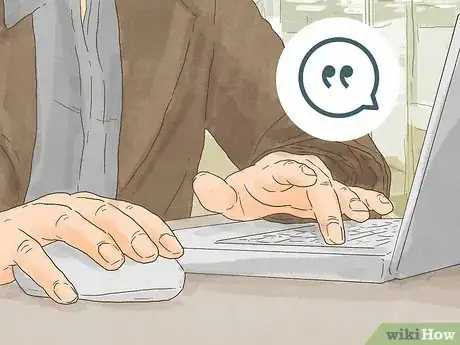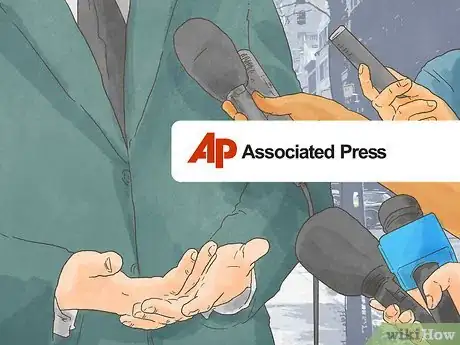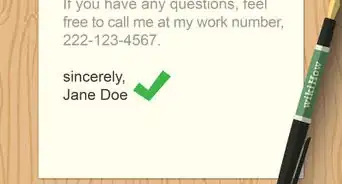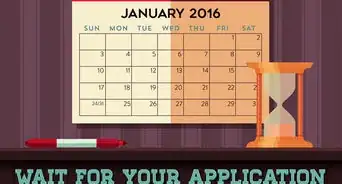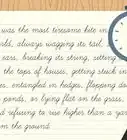This article was co-authored by Janet Peischel. Janet Peischel is a Writer and Digital Media Expert and the Owner of Top of Mind Marketing. With more than 15 years of consulting experience, she develops content strategies and builds online brands for her clients. Prior to consulting, Janet spent over 15 years in the marketing industry, in positions such as the Vice President of Marketing Communications for the Bank of America. Janet holds a BA and MA from the University of Washington.
There are 9 references cited in this article, which can be found at the bottom of the page.
wikiHow marks an article as reader-approved once it receives enough positive feedback. In this case, 100% of readers who voted found the article helpful, earning it our reader-approved status.
This article has been viewed 220,329 times.
Columns are articles or features written for newspapers, magazines, newsletters, and other publications. They are usually published regularly and on a schedule. Columns are a form of journalism that is less formal and more biased than other types of journalism. Choose the content you want your column to be about and then write your column following simple guidelines.
Steps
Sample Columns
Choosing the Content
-
1Determine why you are writing a column. Figure out what you (or your editor) want the column to be about. Do you want to entertain or inform? Asking yourself why you are writing a column will help you figure out what you want to write about. If you want to entertain, you might want to write about humorous topics or make a serious topic comical. Wanting to inform your audience might mean your column is more factual, educational, and serious.[1]
-
2Write about your opinion. Unlike more traditional forms of journalism (such as news reports or articles), a column is by nature biased and opinionated. Think of a topic that you are passionate about and that you have a strong opinion on when figuring out your content. It will be a lot easier to write a column if you care about the subject.[2]
- Although a column is biased, you should still have journalistic integrity and not maliciously slander anyone.
Advertisement -
3Choose relevant topics. News stories come and go very quickly. When writing a column on recent events, move fast. You will want to write a column about a recent event within 24-48 hours after the event happened. Choose relevant topics that you have good perspective or advice about.
- For example: if a political debate happens on a Sunday, you will want a column on your viewpoint of the debate written by Monday or Tuesday.
- Check social media to see what people are posting about and get ideas for your column.[3]
-
4Write about people. Choose topics for your column where you can write about people. Using real people in your column gives it a stronger impact and helps you prove your point.[4] Writing about concepts and policies without using names does not have as much of an effect as using real names.[5]
- For example: if you are writing a column on your opinions on immigration, use the story of a local immigrant in your column.
-
5Localize and personalize your column. If you are writing a column for a local publication, then make sure to give issues a local point of view as much as you can. You can also use your own experiences to show you understand something from a first hand experience.
- For example: if you are talking about problems in the education system, don’t be too general. Focus on the schools in your town and the problems kids in your town have faced or still face at school.
-
6Stick to a theme. Keep your column about the same general topic (politics, beauty, local issues, etc.). However, you should have variation within your theme. Your readers might get bored of your column if they feel like they are reading the same thing repeatedly.[6]
- For example: if your theme is beauty you can talk about curly hair in one piece, eyeliner in another, and lipstick in another.
-
7Write about personal topics. Don’t be afraid to write articles on personal topics. Your views are out in the open in columns. Write about topics that allow you to reveal and expose yourself. This personalization and vulnerability is what will make readers keep reading your column.[7]
- For example: if you are passionate about helping the homeless population, write about your feelings on homelessness in your column.
- If you have five dogs, then write a piece about dogs and include information about your own experiences with dogs.
-
8
-
9Create a structure. There are different structures for columns. You can have a personal column about a specific subject or about a variety of subjects. You might want a column that is in the form of “question and answer,” to give advice or to educate. Informative columns can also be written in a “how to” format.[10]
Creating Your Column
-
1Write clearly. Don’t complicate your column with confusing and technical language. Keep your writing simple. Use short sentences and paragraphs.[13] Start a new paragraph whenever you have a new thought, even if that means a paragraph is only a sentence or two.
- Your column should be between 600 and 800 words.[14]
-
2Write in AP Style. Journalistic writing is usually written in Associated Press (AP) Style. This style includes specific requirements for abbreviations, grammar, titles, and names. Refer to an AP Style guidebook or search online to learn the rules of AP Style when writing your column.[15]
-
3Use first person. In a column, don’t be afraid to talk about yourself as yourself. When writing your opinions, say it is your opinion. Don’t refer to yourself or quote yourself in third person (either by your name or as “the author” or “the reporter”).[16]
- For example, you could write: “I find it horrific that our taxes are not being used to help more homeless people find jobs.”
- Don’t write: “Sara Finn, the author, was horrified to discover her taxes were not being used to help more homeless people find work.”
-
4Write the way you talk. A column is more personal than other types of journalism. Your language in a column does not have to be as formal. While maintaining good grammar, keep your tone casual and personal. [17]
- Don’t write too formal: “Hell’s Kitchen, a neighborhood in New York City, is known for its variety of delicious restaurants.”
- Instead write: “As a self-proclaimed 'pasta expert,' I thought I knew good pasta. However, when I went to Hell’s Kitchen during my trip to New York, I ate fettuccine that changed my life.”
-
5Write an attention grabbing lead. The “lead” (or lede) is the opening section of your column. Unlike traditional new reporting, your column should have a descriptive and attention grabbing lead.[18] [19]
- For example: “It was 11 p.m. and I still had not eaten dinner. I was starving, angry, and lost in New York City. I finally found an Italian restaurant that was still open and ran inside, completely unaware that I was about to have fettuccine that would change my opinion on pasta forever.”
-
6Use facts. Your column should not be a huge list of facts, but you should back up your statements with facts to make your opinions more concrete. Even though a column is not a news report, you still might want to conduct interviews and do online research to back up your points. You will be taken more seriously if you know what you are talking about.[20]
-
7Use analogies to simplify your writing. If you are explaining something complicated or technical, use analogies to simplify and make your point. This will help your readers understand what you are saying in your column.[21]
- For example: “When trying to understand how the business was hiding their money to get out paying taxes, think of the files on your laptop. When you put files in the “trash can” they seem gone, but really they are still there and accessible if you drag them out. The CEO put his money into a “trash can,” so the government would not see it.”
-
8Be passionate, but have a solution. A column is the perfect time to be passionate about your point of view. Share your opinions and viewpoints loud and clear. However, you can’t just write a column of you complaining about an issue. You need to finish off your column with solutions. The audience of your column wants your opinion and they want answers. [22]
- For example: “I am disappointed and disgusted by the number of homeless veterans living on our streets. Let's raise the taxes of the wealthy and use that money to help the homeless.”
Community Q&A
-
QuestionWhat's the main difference between an article and a column?
 Community AnswerWriting an article is objective, as its main purpose is to inform the audience. On the other hand, a column is subjective since it aims to give an opinion on a subject matter.
Community AnswerWriting an article is objective, as its main purpose is to inform the audience. On the other hand, a column is subjective since it aims to give an opinion on a subject matter. -
QuestionI would really love to write in one of those Q&A columns. How do I know I've got what it takes?
 Community AnswerThe only way to find out is to write a column and submit to a newspaper! Don't be discouraged if your column doesn't get published the first time. It often takes many submissions to many different newspapers. Try first submitting your column to a local newspaper.
Community AnswerThe only way to find out is to write a column and submit to a newspaper! Don't be discouraged if your column doesn't get published the first time. It often takes many submissions to many different newspapers. Try first submitting your column to a local newspaper. -
QuestionHow can you write about personal experiences with neighbours and friends without getting in trouble? Do you have to ask their agreement for publishing? Etc.
 Community AnswerSince columns are places for opinions you can write your opinion on an event that has happened, so long as it is based on provable facts. If you acknowledge the other side of your opinion, this will help make you seem fair and balanced. Your readers won't want to read about a neighborhood squabble, so make sure the story relates to some larger, nationwide issue. You will need to properly cite any people you quote, so likely you will have to interview these neighbors.
Community AnswerSince columns are places for opinions you can write your opinion on an event that has happened, so long as it is based on provable facts. If you acknowledge the other side of your opinion, this will help make you seem fair and balanced. Your readers won't want to read about a neighborhood squabble, so make sure the story relates to some larger, nationwide issue. You will need to properly cite any people you quote, so likely you will have to interview these neighbors.
References
- ↑ https://projects.iq.harvard.edu/files/hks-communications-program/files/new_seglin_how_to_write_an_oped_1_25_17_7.pdf
- ↑ https://projects.iq.harvard.edu/files/hks-communications-program/files/new_seglin_how_to_write_an_oped_1_25_17_7.pdf
- ↑ Janet Peischel. Digital Media Expert. Expert Interview. 30 March 2021.
- ↑ http://extension.missouri.edu/p/CM360
- ↑ https://mmhapu.ac.in/doc/eContent/MJMC/ArchanaBharti/Column%20Writing%20Tips_MJMC_SEM%202_PAPER%20203.pdf
- ↑ https://projects.iq.harvard.edu/files/hks-communications-program/files/new_seglin_how_to_write_an_oped_1_25_17_7.pdf
- ↑ http://www.writersdigest.com/online-editor/want-to-write-a-column-here-are-7-key-tips-you-need-to-know
- ↑ Janet Peischel. Digital Media Expert. Expert Interview. 30 March 2021.
- ↑ https://projects.iq.harvard.edu/files/hks-communications-program/files/new_seglin_how_to_write_an_oped_1_25_17_7.pdf
- ↑ http://extension.missouri.edu/p/CM360
- ↑ http://topics.nytimes.com/top/reference/timestopics/people/r/claiborne_ray/index.html?action=click&contentCollection=Science&module=Byline®ion=Header&pgtype=article
- ↑ http://www.nytimes.com/column/maureen-dowd
- ↑ http://extension.missouri.edu/p/CM360
- ↑ https://projects.iq.harvard.edu/files/hks-communications-program/files/new_seglin_how_to_write_an_oped_1_25_17_7.pdf
- ↑ https://owl.purdue.edu/owl/subject_specific_writing/journalism_and_journalistic_writing/ap_style.html
- ↑ https://www.grammarly.com/blog/first-second-and-third-person/
- ↑ http://extension.missouri.edu/p/CM360
- ↑ Janet Peischel. Digital Media Expert. Expert Interview. 30 March 2021.
- ↑ http://extension.missouri.edu/p/CM360
- ↑ https://mmhapu.ac.in/doc/eContent/MJMC/ArchanaBharti/Column%20Writing%20Tips_MJMC_SEM%202_PAPER%20203.pdf
- ↑ https://mmhapu.ac.in/doc/eContent/MJMC/ArchanaBharti/Column%20Writing%20Tips_MJMC_SEM%202_PAPER%20203.pdf
- ↑ https://mmhapu.ac.in/doc/eContent/MJMC/ArchanaBharti/Column%20Writing%20Tips_MJMC_SEM%202_PAPER%20203.pdf
About This Article
To write a column, start by picking a topic you're passionate about, like relationships or movies. Additionally, choose a structure for your column, such as a "how to" format, a traditional essay style, or a “question and answer” space. Once you begin writing, make sure to have clear, simple sentences and to keep the length somewhere between 600 and 800 words. Additionally, write in AP Style, which has specific requirements for abbreviations, grammar, titles, and names. To learn how to write an attention grabbing lead, keep reading!



